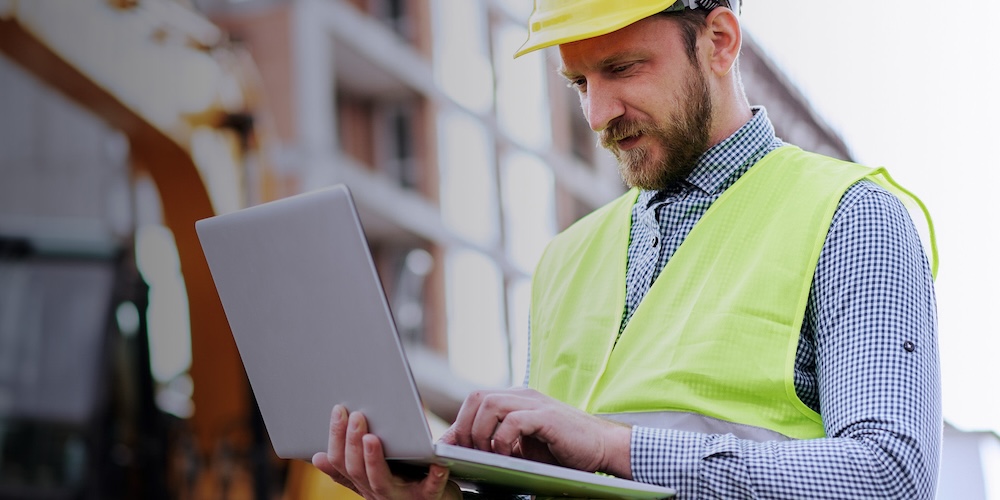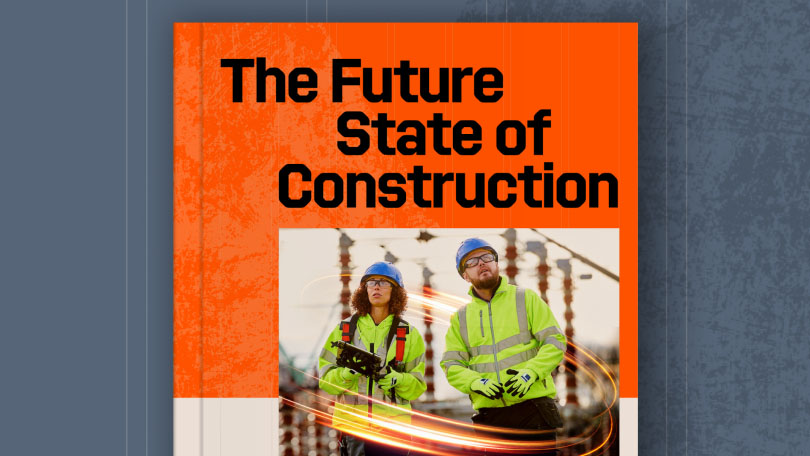— 12 min read
What is a Common Data Environment (CDE)?

Last Updated Sep 16, 2025

Paula Flannery
Global Product Consultant
Paula is a strategic and customer-focused Product Solutions Consultant with a passion for transforming complex technical concepts into compelling, results-driven business solutions. With a background spanning SaaS, enterprise-scale solutions, and digital transformation within the AEC sector, she specialises in bridging the gap between technical innovation and customer success. Bringing over ten years of experience in construction information management across residential and commercial projects in London, as well as European Hyperscale Data Centres, Paula offers a deep understanding of the unique challenges and opportunities in the built environment. This hands-on industry insight allows her to tailor solutions that are both technically robust and operationally relevant. Her expertise lies in driving product adoption, crafting impactful go-to-market strategies, and delivering hands-on technical consultancy that enhances business outcomes. She excels at working with cross-functional teams to build and implement scalable solutions that meet both business objectives and user needs. Whether facilitating enterprise-level Proof of Concept (PoC) initiatives, supporting global product rollouts, or leading technical training sessions, Paula thrives on making technology accessible, valuable, and results-oriented.

Nicholas Dunbar
Content Manager
62 articles
Nick Dunbar oversees the creation and management of UK and Ireland educational content at Procore. Previously, he worked as a sustainability writer at the Building Research Establishment and served as a sustainability consultant within the built environment sector. Nick holds degrees in industrial sustainability and environmental sciences and lives in Camden, London.
Last Updated Sep 16, 2025

A common data environment (CDE) is a centralised, digital platform serving as a single source of truth for project information, enabling collaboration and reducing errors for both live and historic projects. A CDE helps construction professionals keep all project information organised and accessible to those who need it, providing a single source of truth. This ensures that the documents teams access are the most up-to-date and accurate versions, so everyone is working from the same, correct version of a document.
Table of contents
Types of Documents in a CDE
Construction teams store all the documents for every phase of a project, from pre-construction to post-construction, in a CDE. These include, but are not limited to:
+ Drawings
+ Method statements
+ Project specifications
+ Contracts
+ Technical submittals
+ Meeting minutes
+ Reports
+ Programmes and schedules
It is also important that teams store all the data from historic projects in their CDE, not just live projects. Keeping previous project data within the CDE makes processes such as handovers and identifying lessons learned quicker and easier, as the team or manager can find all the relevant information in one place rather than hunting around for data in different locations.
Features of a CDE
CDEs have many features that help make the storage and access of data more streamlined and efficient. These features include:
Centralised Data Storage
CDEs allow construction professionals to store all their data in a single, unified source of truth that the owner can manage from a central location. This centralised approach ensures that all stakeholders in a project are working and communicating from the same documents and data. This improved way of information sharing reduces the risk of differences in data or mistakes because users are accessing accurate information. Having a single location also speeds up access to documents as they are stored efficiently in clear, simple folders. That means users don’t need to search in different systems for the documents they need.
Real-Time Data Access
A Common Data Environment (CDE) is a digital platform that enables real-time access to project information, regardless of whether it is hosted in the cloud, on-premises, or in a hybrid setup. This means updates can be made and shared instantly, eliminating the need to wait for new versions of documents—everyone works from the most current data. All stakeholders benefit from increased transparency and access to real-time information, supporting better data-driven decision making. This agility is essential in the fast-paced construction environment, where delays can lead to schedule overruns and increased costs.
Security and Encryption
CDEs safeguard project data with enterprise-grade security: encryption at rest and in transit, multi-factor authentication, and regular penetration testing protect files from unauthorised access. Combined with granular role-based permissions and the immutable audit trail, these controls ensure only approved users can see or change information while providing a clear record for any compliance review.
Version Control
Version control is a very important feature of using a CDE. Version control is a system that helps document controllers to name and label documents to keep a record of their status and revisions. This helps to ensure access to the right documents and reduces the risks that could occur if people worked with the wrong version. It also makes it easy to track the changes that take place between different documents, and who made the changes, which can be helpful for compliance and reporting.
Every change feeds into an immutable audit trail, time-stamping uploads, edits and approvals so teams can quickly prove compliance and settle any disputes.
End-to-End Project Lifecycle Management
A well-implemented CDE follows the project from first bid to final decommissioning. During pre-construction it houses feasibility studies, estimates and early BIM models; once on site it becomes the live hub for drawings, RFIs and schedules. At handover the same repository captures as-built models, O&M manuals and health-and-safety files, making close-out faster and more accurate. After completion, facilities teams keep using the CDE as a digital twin, logging maintenance records and future refurb plans on the exact data set created during design. Because every phase shares the same single source of truth, knowledge isn’t lost between stakeholders, rework is minimised and asset information stays reliable for decades.
Role-Based Access Control
Role-based access control is the process the CDE manager uses to grant permissions that allow specific people to access and edit documents. This is an important feature for a few reasons. Firstly, it ensures that everyone who needs the document can access it. It also means that the CDE manager can limit access to sensitive documents so that only the authorised users can view or edit them. This is particularly useful when there is confidential information that needs to be protected. It also means that people don’t need to manually request access to documents — they will already have access based on their role and permissions, which saves time by reducing extra admin.
Integration
Integration means that the CDE can connect and interact with other tools and software to allow accurate, up-to-date data to flow between separate systems. This helps to maintain a single source of truth no matter where the data is held. It can be useful for sharing data between systems including computer-aided design (CAD) software, Business Information Modelling (BIM), and project management tools. The integration the reduces time and effort that manually entering the data into different systems would take.
Workflow Management
Beyond storage, a CDE streamlines how information moves. Automated workflows route drawings, RFIs, and submittals to the right people, trigger reminders, and log every action for full traceability. Coupled with role-based access and version control, only authorised users can approve the latest revision, speeding decisions and cutting site delays—all while staying ISO 19650-compliant.
Communication Tools
Integrated chat, comment threads, and markup features let teams discuss drawings or reports directly inside the CDE, keeping context and decisions tied to the files they affect. Real-time notifications alert stakeholders to questions or updates, while mobile access ensures field crews can capture photos or notes and share them instantly with the office. By centralising dialogue alongside documents, a CDE reduces email clutter, preserves an auditable record of conversations, and keeps everyone aligned on the latest information.
Learn about the future of the built environment - Read Procore's Future State of Construction report
Learn how contractors, subcontractors, and project teams can take advantage of new opportunities to boost efficiency and profitability over the next decade. Download the report to get your roadmap to the future state of construction.

Key Benefits of a CDE
Many of the features listed above are benefits in themselves, but there are even more advantages that construction teams can enjoy using a CDE. Here are three top benefits of using a common data environment:
1. Better Collaboration and Efficiency
Having real-time access to data held in a CDE means that anyone working on the project is working from the same documents. That means that they can stay co-ordinated and all use the same information. As a result, teams and workers don’t need to spend time checking that they are all using the right data — it’s guaranteed by using the version held in the CDE. The clarity this provides reduces any potential confusion and means workers have a common understanding, leading to a more efficient process with stronger data control and overall better outcomes.
Cloud-based access to the CDE also means that workers on site can access any documents remotely with a mobile device, so they can check details together, right in the moment they need it. The ability to check documents on site means they don’t have to check with other team members or return to the office to ask the construction project manager, further streamlining their work. Increased collaboration means increased productivity, as teams can work efficiently without the need to resolve issues that could result from differences of information or understanding.
2. Risk and Rework Reduction
CDEs help to reduce risk across multiple points and processes in a construction project. Version control is one of the ways CDEs help to reduce risk. The risk of working from the wrong document — leading to rework and wasting materials — is minimised, as the version control protocol ensures workers are always using the most up-to-date, accurate information. Role-based access also reduces the risk of unauthorised users editing documents and introducing errors, as only authorised users can make changes. A CDE can even limit who can view certain documents.
3. Enhanced Compliance and Security
Compliance is an important aspect of construction processes of all kinds. A CDE can help construction businesses prove their compliance by keeping a record of any changes made that could impact compliance with, for example, Building Regulations and the Construction (Design and Management) Regulations 2015. The organisation of the CDE’s filing system makes it easy to quickly locate documents that are needed in audits and inspections. CDE systems are also secure by design and offer encryption tools that make sure all documents are protected against data breaches. The user-based access controls also prevent unauthorised access that could threaten the privacy of sensitive information.
CDE Implementation: Key Stages & Best Practices
- Discovery & Requirements
• Identify project types, stakeholder needs, and regulatory drivers (e.g., ISO 19650). - Platform Selection
• Compare on-prem, cloud, or hybrid options against security, integration, and cost criteria. - Data Structure & Standards
• Define folder hierarchy, naming conventions, and metadata fields before migration. - Pilot & Data Migration
• Run a small pilot to test workflows, then migrate legacy files in phases with validation checks. - Training & Change Management
• Role-specific training, quick-reference guides, and feedback loops accelerate adoption. - Governance & Continuous Improvement
• Establish an information manager, periodic audits, and KPI tracking to refine processes.
CDE Implementation Best-practice
- Secure executive sponsorship early for budget and authority.
- Map existing BIM workflows so the CDE mirrors, not disrupts, daily tasks.
- Use automation (versioning rules, notifications) to lock in consistency.
- Start with secure defaults—MFA, encryption, and least-privilege access.
Relationship Between BIM and a CDE
Building Information Modelling (BIM) is the collaborative process of creating, managing and analysing digital building models; a Common Data Environment is the secure platform that stores, controls and distributes those BIM models and all related project data. In other words, BIM defines the “what” and “how”, while the CDE supplies the “where” teams access and share that information.
Compliance with the ISO 19650 Standards
The ISO 19650 standard is a global framework that dictates how construction companies should manage information about their projects, including when using BIM. The standard sets out guidelines for how companies must manage information from preconstruction all the way through to decommissioning. It is also part of the UK’s BIM Framework. Following the standard ensures that companies are compliant with the UK’s new standard.
The standard has several parts that focus on different aspects of information management in construction. These include asset and project information, the information delivery cycle, and managing information security risks.
A key part of ISO 19650 related to using a CDE is the use of metadata to organise files. Metadata is descriptive information that adds context to what other data is — it’s essentially data about data. Metadata provides clarification to documents, with factors including the file name, the author, version numbers, creation dates, document types, and more. The standard emphasises that companies should use metadata effectively to ensure that all documents are easily accessible and clear to all parties involved in the project.
Common Challenges of Using a CDE
While there are many benefits to using a CDE, they can also come with challenges. Here are some of the challenges that organisations may face when using a CDE:
Adoption and understanding
For construction workers who haven’t used one before, it can be difficult to know how to effectively navigate a CDE at first. This can be addressed with user training specific to each role, teaching users how they need to interact with the CDE. Many companies also conduct weekly sessions to go through any problems and cover any new features or processes that users need to learn and use. Education and communication are key to getting everyone on board with using the CDE appropriately.
Interoperability
Interoperability can be a challenge that companies need to face. This is especially relevant when you have multiple companies that use different systems. You might even have different business units or subsidiaries in the same company using different systems. A CDE helps get over that hurdle as standardising information is a natural part of using a CDE and helps to tackle this problem. Companies can also use bridge solutions or application programming interfaces (APIs) — software that allows two applications to talk to each other — that help data flow between separate systems securely.
Security breaches
There are always security risks to hosting data online or in the cloud. The CDE’s built-in security features, such as encryption and permissions, can help address this issue. Cybersecurity solutions and training are other important factors that help to keep information, systems, and networks safe. Multi-factor authentication (MFA) also helps to block unauthorised users attempting to get access to information stored in the CDE. MFA is a common security method in which the user verifies their identity with another factor, such as a code sent to their email address, and should be a standard part of a construction company’s cybersecurity practices.
Future Trends for CDEs
CDE solutions continue to evolve and benefit from new technological advancements. Here are some of the areas we can expect to see positive changes to the features and usage of CDEs:
Advanced Analytics and Artificial Intelligence
Analytics and artificial intelligence (AI) rely on having lots of data, and the CDE is a perfect example of an environment that can provide this data. Companies are starting to use generative AI (GenAI) tools, such as ChatGPT, to find specific information and to help with decision making. Applying advanced analytics to the data held in CDEs can also help data-driven decision making and support predictive analytics.
Managing Sustainability Data
As more environmental regulations, such as the Corporate Sustainability Reporting Directive, come into play, the ability to store and provide data on sustainable practices is becoming ever more important. The ability to tag files with metadata, and manage and organise files, is already proving useful in creating sustainability reports. We may see even more sustainability-related features or systems cropping up in CDEs that further streamline the ability to track and manage sustainability data and reports.
Categories:
Written by

Paula Flannery
Global Product Consultant | Procore Technologies
Paula is a strategic and customer-focused Product Solutions Consultant with a passion for transforming complex technical concepts into compelling, results-driven business solutions. With a background spanning SaaS, enterprise-scale solutions, and digital transformation within the AEC sector, she specialises in bridging the gap between technical innovation and customer success. Bringing over ten years of experience in construction information management across residential and commercial projects in London, as well as European Hyperscale Data Centres, Paula offers a deep understanding of the unique challenges and opportunities in the built environment. This hands-on industry insight allows her to tailor solutions that are both technically robust and operationally relevant. Her expertise lies in driving product adoption, crafting impactful go-to-market strategies, and delivering hands-on technical consultancy that enhances business outcomes. She excels at working with cross-functional teams to build and implement scalable solutions that meet both business objectives and user needs. Whether facilitating enterprise-level Proof of Concept (PoC) initiatives, supporting global product rollouts, or leading technical training sessions, Paula thrives on making technology accessible, valuable, and results-oriented.
View profileReviewed by

Nicholas Dunbar
Content Manager | Procore
62 articles
Nick Dunbar oversees the creation and management of UK and Ireland educational content at Procore. Previously, he worked as a sustainability writer at the Building Research Establishment and served as a sustainability consultant within the built environment sector. Nick holds degrees in industrial sustainability and environmental sciences and lives in Camden, London.
View profileExplore more helpful resources

Construction Management Contracts: A Complete UK Guide
Managing construction contracts can lead to an extensive physical paper trail. Sharing contracts, getting signatures and managing timelines is difficult when teams and clients are scattered across job sites and...

Key Differences Between Contractors & Subcontractors
In UK commercial construction, main (or principal) contractors engage directly with project owners to deliver complete construction programmes, while subcontractors perform specific scopes of work under the main contractor’s management....

The Role of RFPs in UK Construction Projects
Requests for Proposals (RFPs) are a core document for construction procurement in the United Kingdom. Effective RFPs align expectations, establish clear evaluation criteria, and create accountability between clients and contractors....

Financial Management in Construction Projects
Effective financial management can make or break construction projects. Teams that master budgeting, cash flow and cost control are better positioned to deliver projects on time, within budget and with...
